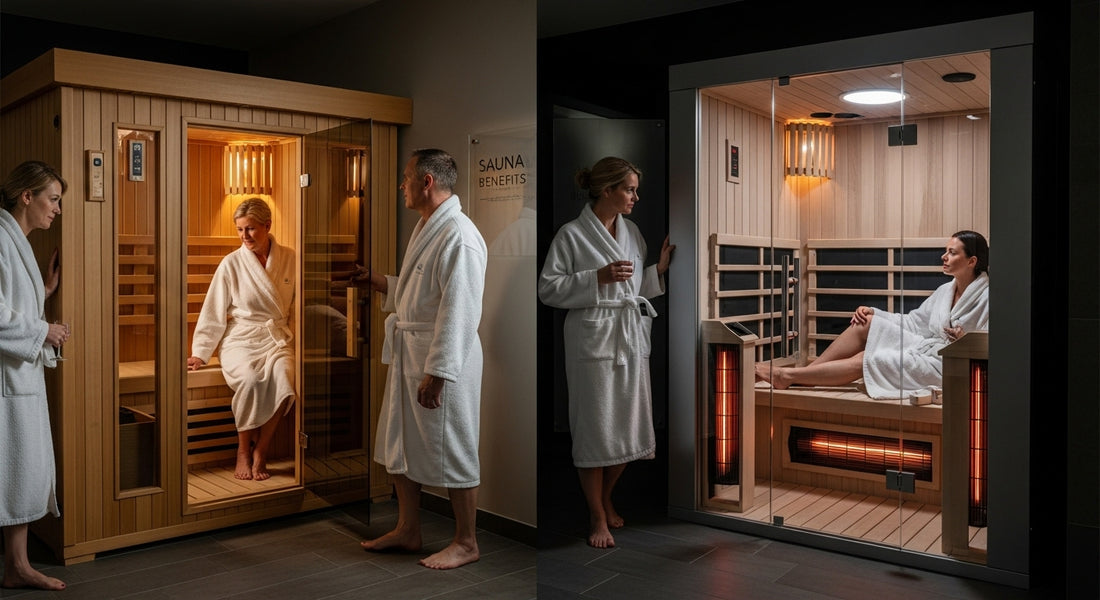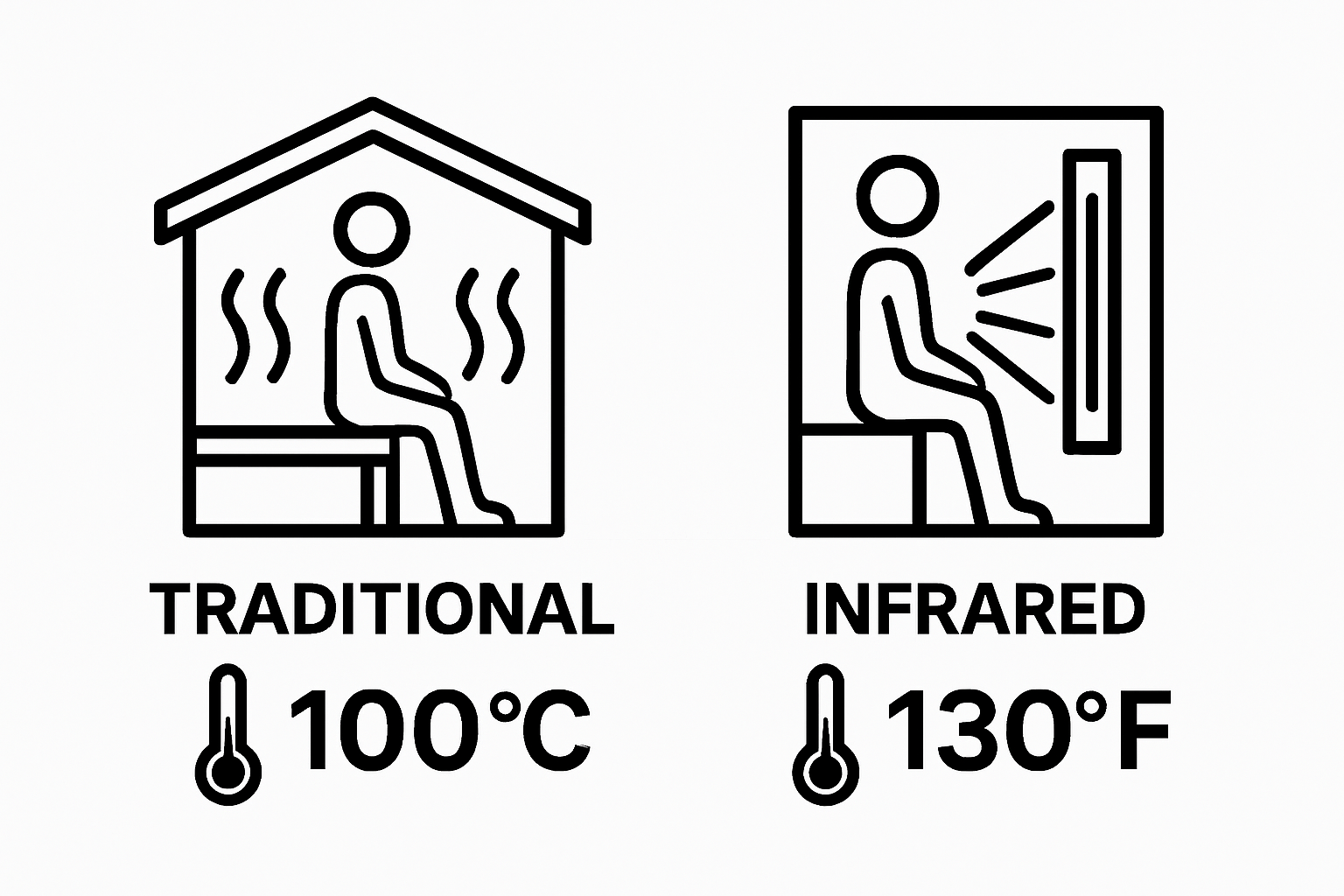
Understanding Traditional vs Infrared Sauna Benefits
Saunas have quietly become a staple in wellness routines across the world, with millions now using them to support everything from relaxation to heart health. Yet while most people assume all saunas work the same way, the science behind each type could not be more different. And here is a surprise: infrared saunas run at nearly 80°F lower temperatures than traditional saunas, but can actually deliver deeper heat right into your muscles. This unexpected contrast is only the beginning of how these two sauna styles change your body and your experience.
Table of Contents
- What Is A Traditional Sauna And How Does It Work?
- What Is An Infrared Sauna And Its Operating Principles?
- Comparative Benefits Of Traditional Vs Infrared Sauna
- The Impact On Health: Traditional Vs Infrared Sauna
- Choosing The Right Sauna For Your Wellness Journey
Quick Summary
| Takeaway | Explanation |
|---|---|
| Choose sauna type based on goals | Traditional and infrared saunas serve different health purposes. Determine your primary health objectives to select the most suitable one. |
| Understand physiological responses | Both sauna types induce beneficial body responses, but the intensity and method differ. Traditional saunas cause immediate sweating and cardiovascular changes, while infrared saunas provide deeper tissue warmth. |
| Assess personal heat tolerance | Evaluate your comfort with high temperatures before using a sauna. Traditional saunas have higher heat levels, which may not be suitable for everyone. |
| Sauna sessions aid detoxification | Both types stimulate sweating and promote toxin elimination, enhancing detoxification processes in the body when utilized regularly. |
| Consult professionals for best use | Professional guidance can help tailor sauna therapy to your individual health conditions, ensuring effective and safe use in your wellness routine. |
What is a Traditional Sauna and How Does It Work?
Traditional saunas represent an ancient wellness practice with roots deeply embedded in Nordic culture, particularly in Finland. These heat therapy spaces offer a unique approach to relaxation, detoxification, and physical recovery through controlled environmental heating.
The Core Mechanics of Traditional Sauna Design
Traditional saunas operate on a simple yet profound heating principle. Unlike modern infrared alternatives, these saunas heat the surrounding air to extremely high temperatures, typically ranging between 70°C and 100°C (158°F to 212°F). The primary heating mechanism involves a specialized stove or heater, often containing large stones that retain and radiate heat effectively.
Key characteristics of traditional sauna design include:
- Wooden interior construction, typically using cedar, pine, or spruce
- High temperature range designed to induce significant sweating
- Option to create steam by pouring water onto heated rocks
- Precise temperature and humidity control
Physiological Responses to Traditional Sauna Sessions
When you enter a traditional sauna, your body undergoes remarkable physiological transformations. The intense heat triggers multiple biological responses that contribute to overall wellness. According to research from the National Institutes of Health, exposure to high temperatures causes immediate cardiovascular changes, including increased heart rate and enhanced blood circulation.
The sweating process in a traditional sauna serves multiple purposes. As your body temperature rises, sweat production accelerates, helping to:
- Eliminate toxins through skin pores
- Regulate internal body temperature
- Provide a natural cardiovascular workout
- Potentially improve skin health and appearance
Traditional saunas distinguish themselves from infrared alternatives by creating a comprehensive heat environment that envelops the entire body. This full-body heating approach stimulates deeper physiological responses, offering a more intense and traditional wellness experience that has been practiced for centuries across Nordic cultures.
What is an Infrared Sauna and Its Operating Principles?
Infrared saunas represent a modern approach to heat therapy, utilizing advanced light technology to deliver therapeutic warmth directly to the human body. Unlike traditional saunas that heat the surrounding air, infrared saunas employ specialized electromagnetic waves to generate heat from within.
The Science Behind Infrared Heating Technology
Infrared saunas operate through a sophisticated heating mechanism that differentiates them from conventional heat therapy approaches. These innovative wellness spaces use infrared light waves, which are invisible to the human eye but capable of penetrating deep into body tissues. The heating process occurs at lower ambient temperatures compared to traditional saunas, typically ranging between 110°F and 130°F.
Key technological components of infrared saunas include:
- Specialized infrared emitters using carbon or ceramic heating elements
- Precise wavelength control for optimal therapeutic penetration
- Lower ambient temperatures enabling longer, more comfortable sessions
- Direct body heating mechanism rather than air temperature elevation
Physiological Interactions and Health Responses
The unique heating mechanism of infrared saunas triggers distinctive physiological responses.
According to research from the Mayo Clinic, infrared light penetrates approximately 1.5 inches beneath the skin, generating heat directly within body tissues. This process induces a range of potential health benefits:
- Enhanced circulation and cardiovascular performance
- Accelerated metabolic processes
- Potential muscle recovery and tension reduction
- Stimulation of the body’s natural detoxification mechanisms
Infrared saunas distinguish themselves by offering a gentler, more controlled heat experience that allows individuals to experience therapeutic warmth without the intense temperatures associated with traditional sauna environments. By directly warming the body at a cellular level, these innovative wellness spaces provide a modern alternative to conventional heat therapy practices.
Comparative Benefits of Traditional vs Infrared Sauna
Both traditional and infrared saunas offer unique wellness experiences, each with distinctive approaches to heat therapy and physiological stimulation. Understanding their fundamental differences helps individuals select the most appropriate sauna experience for their personal health goals and comfort preferences.
Below is a comparison table summarizing the key differences between traditional and infrared saunas to help you determine which is best suited to your needs.
| Feature | Traditional Sauna | Infrared Sauna |
|---|---|---|
| Heating Method | Heats the air, which then warms the body | Uses infrared light waves to heat the body |
| Temperature Range | 158°F–212°F (70°C–100°C) | 110°F–130°F |
| Humidity Option | Can create steam with water on hot rocks | Dry heat only |
| Primary Material | Cedar, pine, or spruce wood | Often wood with carbon/ceramic heaters |
| Sweating Intensity | Intense and rapid | Moderate but penetrates deeper |
| Session Comfort | Shorter sessions due to high heat | Longer, more comfortable sessions possible |
| Unique Benefit | Full-body heat, strong cardiovascular effect | Deep tissue warming, gentler on the body |
Heating Mechanism and Temperature Dynamics
The primary distinction between traditional and infrared saunas lies in their heating strategies.
 Traditional saunas create a high-temperature environment that heats the surrounding air, typically ranging from 70°C to 100°C. In contrast, infrared saunas operate at lower ambient temperatures between 110°F and 130°F, directly warming body tissues through electromagnetic waves.
Traditional saunas create a high-temperature environment that heats the surrounding air, typically ranging from 70°C to 100°C. In contrast, infrared saunas operate at lower ambient temperatures between 110°F and 130°F, directly warming body tissues through electromagnetic waves.
Key comparative heating characteristics include:
- Traditional saunas heat air first, then transfer warmth to the body
- Infrared saunas penetrate body tissues directly with light waves
- Traditional saunas require higher temperatures for similar physiological responses
- Infrared saunas enable longer, more comfortable sessions due to lower air temperatures
Physiological Response and Health Impact
According to research published in comparative thermal studies, the physiological responses to traditional and infrared saunas differ significantly. Traditional saunas induce more rapid cardiovascular changes through intense heat exposure, while infrared saunas provide a gentler, more targeted approach to tissue warming.
Comparative health benefits include:
- Traditional saunas offer more intense sweating and immediate cardiovascular stimulation
- Infrared saunas provide deeper tissue penetration with less environmental heat stress
- Both methods potentially support detoxification and metabolic processes
- Individual tolerance and specific health objectives should guide sauna selection
Ultimately, the choice between traditional and infrared saunas depends on personal preferences, health conditions, and desired therapeutic outcomes. While traditional saunas offer a more intense, culturally rich experience, infrared saunas provide a modern, targeted approach to heat therapy that may be more accessible for individuals sensitive to extreme temperatures.
The Impact on Health: Traditional vs Infrared Sauna
Sauna therapy represents a holistic approach to wellness that extends far beyond simple heat exposure. Both traditional and infrared saunas offer unique pathways to potential health improvements, each with distinct physiological mechanisms and therapeutic implications.
Cardiovascular and Metabolic Health Responses
The impact of sauna therapy on cardiovascular function is particularly noteworthy. Heat exposure triggers complex physiological adaptations that simulate moderate cardiovascular exercise, creating a range of potential health benefits. Traditional saunas, with their more intense heat environment, typically induce more pronounced cardiovascular responses compared to infrared alternatives.
Key cardiovascular and metabolic effects include:
- Increased heart rate similar to moderate physical activity
- Enhanced blood circulation and peripheral blood vessel dilation
- Potential improvements in metabolic efficiency
- Temporary elevation of heart rate and metabolic performance
Stress Reduction and Neurological Wellness
According to research from the Mayo Clinic, both traditional and infrared saunas demonstrate promising potential for stress reduction and neurological wellness. The controlled heat exposure stimulates the production of heat shock proteins and promotes relaxation through autonomic nervous system modulation.
Potential neurological and stress-related benefits encompass:
- Reduction of cortisol levels and stress hormones
- Enhanced production of endorphins and mood-regulating neurotransmitters
- Improved sleep quality and relaxation response
- Potential mitigation of mild symptoms of anxiety and depression
While both sauna types offer substantial health potential, individual physiological responses can vary significantly.
This table outlines the typical physiological responses and health impacts associated with both traditional and infrared sauna use.
| Sauna Type | Cardiovascular Impact | Detoxification Mechanism | Stress Reduction Approach | Muscle & Tissue Effect |
|---|---|---|---|---|
| Traditional | Increases heart rate and circulation | Induces intense sweating | Rapid relaxation via intense heat | Surface muscle relief |
| Infrared | Enhances circulation, less heat stress | Promotes sweating through gentle heat | Gradual relaxation via deep, gentle warming | Deep tissue and muscle penetration |
| The choice between traditional and infrared saunas should consider personal health conditions, comfort levels, and specific wellness objectives. Consulting healthcare professionals can provide personalized guidance on integrating sauna therapy into a comprehensive wellness strategy. |
Choosing the Right Sauna for Your Wellness Journey
Selecting the ideal sauna involves more than comparing heating technologies. It requires a nuanced understanding of personal health goals, physiological responses, and individual comfort levels. The right sauna can transform your wellness routine, offering targeted therapeutic benefits tailored to your specific needs.
Personal Health Assessment and Considerations
Before selecting a sauna, a comprehensive self-evaluation becomes crucial. Health status, temperature tolerance, and wellness objectives serve as fundamental decision-making criteria. Traditional saunas appeal to those seeking intense heat exposure and cultural authenticity, while infrared saunas attract individuals desiring gentler, more targeted therapeutic experiences.
Key personal assessment factors include:
- Current cardiovascular and metabolic health
- Heat sensitivity and tolerance levels
- Specific wellness and recovery goals
- Existing medical conditions or physical limitations
Matching Sauna Types to Individual Wellness Objectives
According to research in complementary medicine, the selection process transcends basic technology comparison. Each sauna type offers unique physiological interactions that align differently with individual health strategies.
Wellness objective matchmaking considerations:
- Cardiovascular conditioning: Traditional saunas provide more intense cardiovascular stimulation
- Muscle recovery: Infrared saunas offer deeper tissue penetration and gentler heating
- Stress reduction: Both sauna types support relaxation through different mechanisms
- Detoxification: Traditional saunas induce more profuse sweating
Ultimately, the most effective sauna is one that aligns seamlessly with your body’s unique requirements, comfort level, and long-term wellness vision. Consulting healthcare professionals can provide personalized insights, ensuring your sauna selection supports your holistic health journey with precision and purpose.

Elevate Your Wellness Journey with the Perfect Sauna Choice
Are you struggling to decide between the intense heat of a traditional sauna and the gentle, penetrating comfort of an infrared model? The article above explains how each type works and highlights that choosing the right sauna is crucial to meeting your specific wellness goals. Key challenges readers face include trying to match health needs—such as cardiovascular support, muscle recovery, or advanced detoxification—with the right sauna technology and environment.

Experience the difference firsthand and transform your wellness routine at Best Life Sauna. We provide a curated collection of premium sauna solutions that align with your personal goals, whether you value deep relaxation or want targeted muscle recovery. Visit our website today for exclusive offers like free shipping on orders over $200. Take the next step toward living your healthiest life—explore our selection, read real customer reviews, and find the sauna that suits your needs right now.
Frequently Asked Questions
What are the key differences between traditional and infrared saunas?
Traditional saunas heat the surrounding air to high temperatures (70°C to 100°C) to create a hot environment, while infrared saunas use infrared light waves to directly warm the body at lower ambient temperatures (110°F to 130°F).
What are the health benefits of using a traditional sauna?
Traditional saunas promote intense sweating, support cardiovascular health through increased heart rate, enhance blood circulation, and may improve skin health and detoxification through the sweating process.
How does the heat from an infrared sauna affect the body?
Infrared saunas penetrate approximately 1.5 inches into the skin, promoting deeper tissue warming, enhanced circulation, and potential benefits for muscle recovery and metabolic processes without the higher heat stress of traditional saunas.
Which sauna type is more suitable for stress reduction?
Both traditional and infrared saunas are effective for stress reduction. Traditional saunas may induce rapid cardiovascular relaxation, while infrared saunas can stimulate relaxation through gentler heating, allowing for a more comfortable experience.

